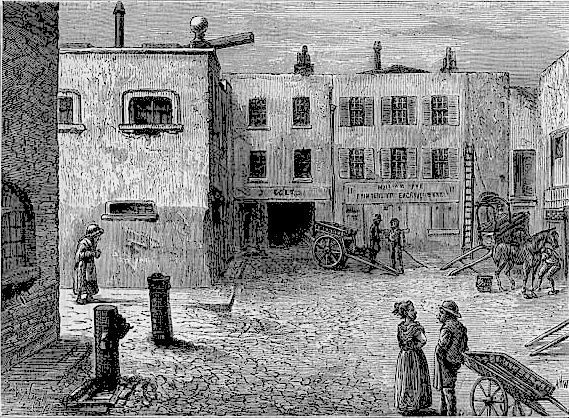Major cities London | ||
 | ||
Bleeding heart yard at night
Bleeding Heart Yard is a cobbled courtyard off Greville Street in the Farringdon area of the City of London. The courtyard is probably named after a 16th-century inn sign dating back to the Reformation that was displayed on a pub called the Bleeding Heart in nearby Charles Street. The sign showed the heart of the Virgin Mary pierced by five swords.
Contents
- Bleeding heart yard at night
- Map of Bleeding Heart Yard London EC1N 8SJ UK
- The churchfitters bleeding heart yard
- In literature
- The yard today
- References
Map of Bleeding Heart Yard, London EC1N 8SJ, UK
Urban legend has it that the courtyard's name commemorates the murder of Lady Elizabeth Hatton, the second wife of Sir William Hatton, whose family formerly owned the area around Hatton Garden. It is said that her body was found here on 27 January 1626, "torn limb from limb, but with her heart still pumping blood."
The churchfitters bleeding heart yard
In literature
Bleeding Heart Yard features in the Charles Dickens novel Little Dorrit as the home of the Plornish family. Dickens wrote of it:
[It was] a place much changed in feature and in fortune, yet with some relish of ancient greatness about it. Two or three mighty stacks of chimneys, and a few large dark rooms which had escaped being walled and subdivided out of the recognition of their old proportions, gave the Yard a character. It was inhabited by poor people, who set up their rest among its faded glories, as Arabs of the desert pitch their tents among the fallen stones of the Pyramids; but there was a family sentimental feeling prevalent in the Yard, that it had a character.
Before Dickens, the courtyard was best known for its appearance in R.H. Barham's The Ingoldsby Legends, a collection of poems and stories first published in Bentley's Miscellany beginning in 1837. In one of the stories, The House-Warming: A Legend Of Bleeding-Heart Yard, Lady Hatton, wife of Sir Christopher Hatton, makes a pact with the devil to secure wealth, position, and a mansion in Holborn. During the housewarming of the mansion, the devil dances with her, then tears out her heart, which is found, still beating, in the courtyard the next morning. It is from this legend, together with a case of mistaken identity, that the myth of Lady Elizabeth Hatton's murder — wife, not of Christopher, but of William Hatton — was born.
"Bleeding Heart Square" by Andrew Taylor (published by Michael Joseph 2008 and by Penguin Books 2009). A gothic thriller and crime novel combined, "Bleeding Heart Square" is set in the 1930s in and around Bleeding Heart Yard and the adjacent Ely Place. Many of the street names in the area, e.g. Holborn Circus, Farringdon Road and Hatton Garden remain unchanged, but many have been altered, in keeping with a long and respected tradition among novelists.
The yard today
A French restaurant, bistro and tavern called The Bleeding Heart now occupies a number of the buildings in the courtyard. A gate at the south of the yard leads to Ely Place.
Greville Street links Bleeding Heart Yard to another notable street from Charles Dickens' novels: Saffron Hill, which was the home of Fagin in Oliver Twist.
